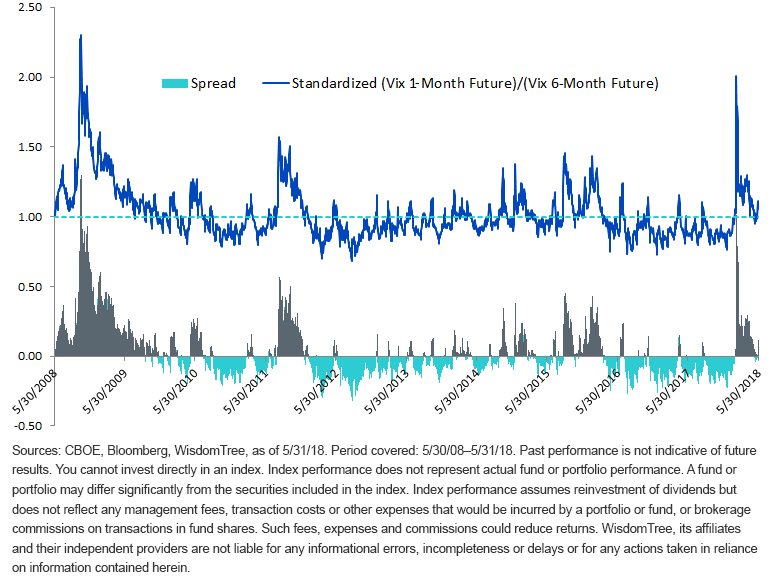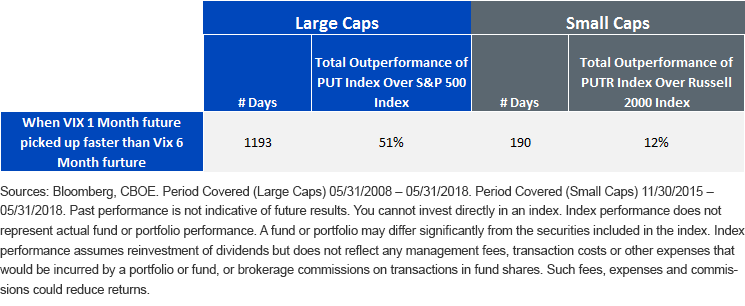What Is VIX Telling Investors?


I have written on the jump in the VIX that occurred in February, taking investors by surprise. While there was a precursor to this unprecedented surge in the VIX (a compression of spreads between implied minus realized volatility), it was subtle and the move was very sudden. VIX moves are important due to their strong negative correlation to equities.
In this blog post, I will highlight another relatively more stable signal we have been following and the one that has been flashing red for some time, the VIX futures curve. I will also talk about strategies that can cushion market corrections that typically follow periods of heightened volatility.
VIX Futures Curve: A Signal to Watch
The VIX is indicative of one-month implied or forward volatility. When there is a spike in the VIX, it simply means investors anticipate higher volatility in the future.
Now, most investors are aware of term-structure curves in relation to commodity futures curves. Similarly, VIX can also have a futures curve where different points in the curve imply investors’ anticipation of implied volatilities at that time.
Under normal circumstances, as one moves further out in the future on the curve, corresponding values should be higher, partly because six months have more uncertainty than, say, one month.
In other words, usually six-month minus one-month VIX futures spreads should be positive. Commodity traders refer to this upward sloping nature of a futures curve as being in “contango,” and it also implies a roll cost every month—why investors structurally long in volatility-hedging products face a strategic headwind.
The exhibit below shows a standardized series of VIX one-month and six-month futures contracts going back 10 years. Out of about 2,610 trading days, there were about 1,193 days (46% of time) when the one-month standardized VIX was higher than the standardized six-month VIX.
To put it simply, VIX one-month futures surged faster than VIX six-month futures (highlighted in gray on the lower chart). It happened during the financial crisis of 2008–09 and during the Greek default and euro-contagion in 2011, and most recently this inversion started on January 29, right before a big spike in VIX on February 5 ahead of the substantial decline in equities in the weeks that followed.
An acceleration in the near-term over medium-term VIX can thus be a strong signal of heightened volatility and possible market corrections.
What can take investors by surprise is that with an occurrence rate of almost 50% (1,193 days out of 2,610 days), this acceleration is not uncommon!
VIX 1-Month Volatility Surpasses VIX 6-Month

How WisdomTree Can Help?
Can investors mitigate these periods of high volatility?
In 2016, WisdomTree launched its first option-selling strategy, the WisdomTree CBOE S&P 500 PutWrite Strategy Fund (PUTW), which tracks the Cboe S&P 500 PutWrite Index (PUT).
This cash-collateralized strategy sells at-the-money (ATM) monthly put options on the S&P 500 Index and collects premiums. Therefore, by generating monthly income by selling put options, this strategy aims to offset losses in a declining market while still providing positive returns during rising markets.
Given PUTW’s popularity and track record, we also launched a small-cap version of the same strategy, the WisdomTree CBOE Russell 2000 PutWrite Strategy Fund (RPUT), which tracks the Cboe Russell 2000 PutWrite Index (PUTR) and sells cash-collateralized monthly ATM options on the Russell 2000 Index.
The table below highlights the relative cumulative outperformance of these option-selling strategies against their respective equity benchmarks during above-discussed periods when short-term volatility surged.

For definitions of terms in the chart, please visit our glossary.
Taking it one step further, I also show the five longest instances in which VIX one-month futures constantly traded higher than VIX six-month futures, for large- and small-cap universes.
Large Caps
PUT Index vs S&P 500 Index

Small Caps
PUTR Index vs Russell 2000 Index

Options selling strategies did what they were designed to do: outperform their respective equity indexes, which were mostly trading negative for those days when volatility had spiked.
Conclusions
Short-term investors try to time markets by developing and watching various signals to time risk on or off, while long-term investors go by a simple rule: Time spent in the market is more important than timing the markets. What connects the two investing themes: To grow your portfolio, your asset allocation should be able to survive the cyclicality of markets’ booms and busts.
Strategies designed to help reduce volatility, such as WisdomTree’s PUTW and RPUT, deserve attention to help stay the course without introducing unique stock selection risk of other low-volatility investment strategies. By incorporating option strategies, investors could outperform not only during periods of stress but also potentially on a longer-term risk-adjusted basis. Additionally, option-selling strategies have the potential to generate higher income for an investor’s portfolio during periods of heightened volatility. We believe PUTW and RPUT are compelling candidates for any risk-sensitive equity asset allocation.
Important Risks Related to this Article
There are risks associated with investing, including possible loss of principal. These Fund will invest in derivatives, including Russell 2000 Index put options (“RUT Puts”) and S&P 500 Index put options (“SPX Puts”). Derivative investments can be volatile, and these investments may be less liquid than other securities, and more sensitive to the effects of varied economic conditions. The value of the RUT Puts and SPX Puts in which the Fund invests is partly based on the volatility used by market participants to price such options (i.e., implied volatility). The options’ values are partly based on the volatility used by dealers to price such options, so increases in the implied volatility of such options will cause the value of such options to increase, which will result in a corresponding increase in the liabilities of the Fund and a decrease in the Fund’s NAV. Options may be subject to volatile swings in price influenced by changes in the value of the underlying instrument. The potential return to the Fund is limited to the amount of option premiums it receives; however, the Fund can potentially lose up to the entire strike price of each option it sells. Due to the investment strategy of the Fund, it may make higher capital gain distributions than other ETFs. Please read the Fund’s prospectus for specific details regarding the Fund’s risk profile.
The Cboe Russell 2000 PutWrite Index (the “Index”) is a trademark of Frank Russell Company (“Russell”) and has been licensed for use by WisdomTree Asset Management. The CBOE Russell 2000 PutWrite Strategy Fund is not in any way sponsored, endorsed, sold or promoted by Russell or the London Stock Exchange Group companies (“LSEG”) (together, the “Licensor Parties”) and none of the Licensor Parties make any claim, prediction, warranty or representation whatsoever, expressly or impliedly, either as to (i) the results to be obtained from the use of the Index (upon which the CBOE Russell 2000 PutWrite Strategy Fund is based), (ii) the figure at which the Index is said to stand at any particular time on any particular day or otherwise, or (iii) the suitability of the Index for the purpose to which it is being put in connection with the CBOE Russell 2000 PutWrite Strategy Fund. None of the Licensor Parties have provided or will provide any financial or investment advice or recommendation in relation to the Index to WisdomTree or to its clients. The Index is calculated by Russell or its agent. None of the Licensor Parties shall be (a) liable (whether in negligence or otherwise) to any person for any error in the Index or (b) under any obligation to advise any person of any error therein.
The Cboe S&P 500 PutWrite Index is a product of S&P Dow Jones Indices LLC or its affiliates (“SPDJI”) and Cboe and has been licensed for use by WisdomTree. Standard & Poor’s® and S&P® are registered trademarks of Standard & Poor’s Financial Services LLC (“S&P”); Dow Jones® is a registered trademark of Dow Jones Trademarks Holdings LLC (“Dow Jones”). These trademarks have been licensed for use by SPDJI and sublicensed for certain purposes by WisdomTree. Cboe® is a trademark of the Chicago Board Options Exchange, Incorporated, and has been licensed for use by SPDJI and WisdomTree. The WisdomTree CBOE S&P 500 PutWrite Strategy Fund is not sponsored, endorsed, sold or promoted by SPDJI, Dow Jones, S&P, their respective affiliates or the Chicago Board Options Exchange, Incorporated, and none of such parties make any representation regarding the advisability of investing in such product(s), nor do they have any liability for any errors, omissions or interruptions of the Cboe S&P 500 PutWrite Index.


